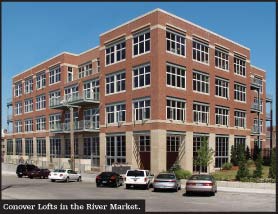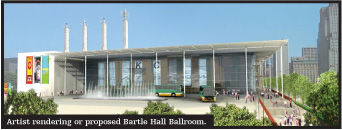
Kansas City's urban core is often treated as a combination of metro
stepchild and black sheep.
Despite jewels such as the Country Club Plaza and Crown Center,
the consensus often seems to be that the area is not living up to its
promise--and never will.
One reason may be that, like the entire metro area, the city's real "downtown" is spread out. Rather than a single area, the community's urban focus is shared between the River Market, Crown Center, Midtown and the Plaza/Brush Creek corridor. This dispersed development can be debated, but it hides the considerable development that is occurring. Viewed as a whole, there is a lot of progress taking place.
One of the biggest surprises may involve the number of residential projects recently completed or under way. Especially downtown, a major priority has been increasing the number of warm bodies who call the area home. As noted in a recent report by private consulting firm Development Initiatives, 15 urban core residential projects have recently been completed, seven more are under way and 17 more are proposed.
The Richards Conover Lofts & Conover Place is a good example. Completed last year, this project included renovation of the JAX building in the historic River Market area into 80 loft apartments and construction of Conover Place, a new loft condominium building with 35 units, built with timber-frame construction.
 This project is not isolated. Recently proposed was a project involving the former TWA Building at 13th and Baltimore being marketed by Master Realty. Possible reuses for this eight-story building are residential loft apartments.
This project is not isolated. Recently proposed was a project involving the former TWA Building at 13th and Baltimore being marketed by Master Realty. Possible reuses for this eight-story building are residential loft apartments.
This building is on the same block as the Hotel President, an example of how these efforts often face considerable challenge. Located at 1329 Baltimore, the President had been slated as a future hotel/convention center by an area developer who bought the building in 2001. The project has faced major funding challenges, including dismissal by the TIF Commission late in 2003. However, the developer is attempting to continue by seeking out-of-town funding.
Most of the public attention is focused on the Downtown Loop. One of the biggest stories is the Fidelity Bank Building or 909 Walnut building. This 33-story office tower sat vacant since the federal government left the structure in 1995. A Dallas developer received TIF money to start recon- struction of the office building and completion has been set for 2004. The plan currently calls for 180 luxury apartment units with an adjoining seven-story, 350-car parking garage. The project includes a 5,000 square foot restaurant open to the public on the ground floor, 70,000 square feet of office space for rent, a health club for residents and a rooftop garden on top of the parking garage. The total cost of the redevelopment is $55 million.
Still in the stage of speculation but potentially significant is the Stuart Hall Building. Located in the center of the historic freight house district and a prime location for a commercial re-use, the structure is potentially a major project for this southern area. Currently owned by DST Systems, one proposal calls for up to 300 loft-housing units.

Several of the biggest success stories in the urban core involve the government. None is bigger than this spring's closure of the Internal Revenue Service regional service center move to the former main post office on Pershing Road. The $300 million plan is estimated to represent 4,000 permanent and 2,000 seasonal IRS employees who will be working in the Crown Center area.
The consolidation also will generate construction in and around the post office and Union Station, where the remaining retail postal service and other operations will move. DST Systems Inc. is the developer.
Back inside the loop, a smaller but equally significant effort involves the new Downtown Kansas City Public Library. Working with the Down-town Council and other partners, the library is rehabilitating a historic bank building in Downtown Kansas City for their new central library which will offer enhanced programming, better access to collections, additional parking and amenities. This $50 million project is scheduled to be open in 2004.
Several major projects have received considerable attention and some debate. The Kauffman Performing Arts Campus has drawn mostly praise, although the design has changed considerably during the design phase. The $305 million facility was announced in 1999 to include a 1,500-seat symphony hall, a 2,000-seat concert hall and a small 400-seat theater. Located on a bluff just south of Bartle Hall, the project will provide a dramatic connection between the Downtown Loop and the Crown Center. Construction is scheduled to start in 2004, with a potential opening date in 2007.
The most controversial and potentially important project may be the much-discussed Downtown Arena. Although no formal plans have been unveiled, the concept seems to be gaining support--despite not having a professional sports franchise tenant. Most dramatically, the arena could be linked to major office development such as relocated facilities for the H&R Block Inc. and Waddell & Reed Financial Inc. Both companies were searching for new headquarters and city officials were aggressively moving to offer a solution. Formal announcements are possible by the end of 2003.
A related project could be the Bartle Hall Ballroom being considered by the City of KCMO and the Kansas City Convention and Visitors Bureau. The group is looking to expand Bartle Hall with a $100 million addition of ballroom and meeting space. The latest of several studies places the ballroom back inside the Downtown Loop. As a more unified greater downtown Kansas City takes shape, a major challenge involves continued redevelop-ment to the south towards the Plaza. Many see the Midtown Marketplace as a key development in bridging that gap.
This $50-70 million Midtown Marketplace has already helped re-vitalize Kansas City's Midtown and add vital services for its residents. The anchor tenants of the retail and office development are Costco and Home Depot. Midtown Marketplace involved acquiring, relocating and demolishing over 140 blighted properties within a 22-acre site. A collaborative effort between the TIF Commission, the City of Kansas City and the Midtown Redevelopment Corporation, the project, took nearly eight years to complete.

The plan also includes a housing component that utilizes excess revenue from the project to fund neighborhood improvements. Begun in the spring of 2001, this Midtown Housing Plan provides grants to owner occupants of single-family homes and owners of qualifying multi-family buildings to renovate the exterior of their properties. The TIF Commission jump-started the effort with a $1 million loan in 2001.
One other project fits none of these categories but could have significant impact. The Riverfront Heritage Trail is being developed from Kansas City, Kan., to the River Market.
Some of the trail is already com- plete along Berkley Riverfront Park. But if all goes according to plan, this section near River Market will be connected to form a nearly uninterrupted path from the Isle of Capri Casino, through Berkley Park, under the ASB Bridge, through the River Market, south on Wyandotte Street and along Ninth Street west to Case Park.
What becomes evident from all of this is combined total of the work. The Downtown Council recently estimated that more than $1.9 billion in new development and investment was under way in the area, including nearly $700 million in new and renovated office space. When combined, these and similar projects propel downtown into the area's top real estate markets. Among the more significant examples were these projects:
» Commerce Trust Building, 922 Walnut St. Commerce Bank is spending $26 million to reconfiguration and rehabilitation the facility into a 270,000 sq. ft. office building by connecting floors across a light well.
» Kansas City Southern Industries Inc., 427 W. 12th St., last year dedicated its new corporate headquarters in Cathedral Square. The building is leased long-term by Kansas City Southern from DST Realty Inc., which developed the project.
» The Kansas City Club, 13th Street and Baltimore Avenue. Partners Mark Latshaw and Bill Love are renovating the historic building into 74 luxury apartments. Latshaw and Love bought the building in March, 2003 for $1.7 million. The cost of the proposed renovation is estimated at $14.5 million.
» The Law Building, 12th Street and Grand Boulevard. An Illinois developer is leading this $6 million renovation. The 50,000-square-foot building will include retail on the ground floor, offices on the second floor and loft apartments on upper levels. While restoration efforts came to an abrupt halt a year ago, it is anticipated that the developer will get on board swiftly or make room for a qualified successor.